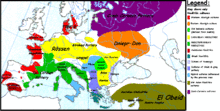Rössen culture
 |
|
| Geographical range | Central Europe: Germany except north, Low Countries, northeast France, north Switzerland and Austria: Northern and Central Hesse, Westphalia, South Lower Saxony, West Thuringia. |
|---|---|
| Period | Middle Neolithic |
| Dates | 4,600–4,300 BC |
| Characteristics | incised pottery: footed bowls, globular cups, flint blades, axes, adzes longhouse settlements, inhumation graves |
| Preceded by | Linear Pottery Culture |
| Followed by | Michelsberg culture |
The Rössen culture or Roessen culture (German: Rössener Kultur) is a Central European culture of the middle Neolithic (4,600–4,300 BC).
It is named after the necropolis of Rössen (part of Leuna, in the Saalekreis district, Saxony-Anhalt). The Rössen culture has been identified in 11 of the 16 states of Germany (it is only absent from the Northern part of the North German Plain), but also in the southeast Low Countries, northeast France, northern Switzerland and a small part of Austria.
The Rössen culture is important as it marks the transition from a broad and widely distributed tradition going back to Central Europe's earliest Neolithic LBK towards the more diversified Middle and Late Neolithic situation characterised by the appearance of complexes like Michelsberg and Funnel Beaker Culture.
Rössen vessels are characteristically decorated with double incisions ("goat's foot incision" or German '"Geißfußstich"') with incrustation of white paste. Grooved or stamped incisions are also common. Over time, the extent of the decorated areas appears to decrease so that on later vessels it is mostly restricted to the neck or entirely absent. Typical shapes include tall footed bowls, globular cups, rectangular sheet-made bowls and boat-shaped vessels.
The surfaces of vessels are usually burnished; their colours range from brown via reddish brown and dark brown to grey-black.
The Rössen repertoire of flint tools is broadly similar to that of the Linear Pottery (LBK) tradition (blades with pyramid-shaped cores), but there is a marked change as regards the raw materials used. Dutch Rijkholt flint, which dominated the LBK tradition, is being replaced with veined 'Plattenhornstein' (Abensberg-Arnhofen type) of Bavarian origin. The most typical solid rock tool is a pierced tall cleaver, but unpierced axes and adzes are also common.
...
Wikipedia
